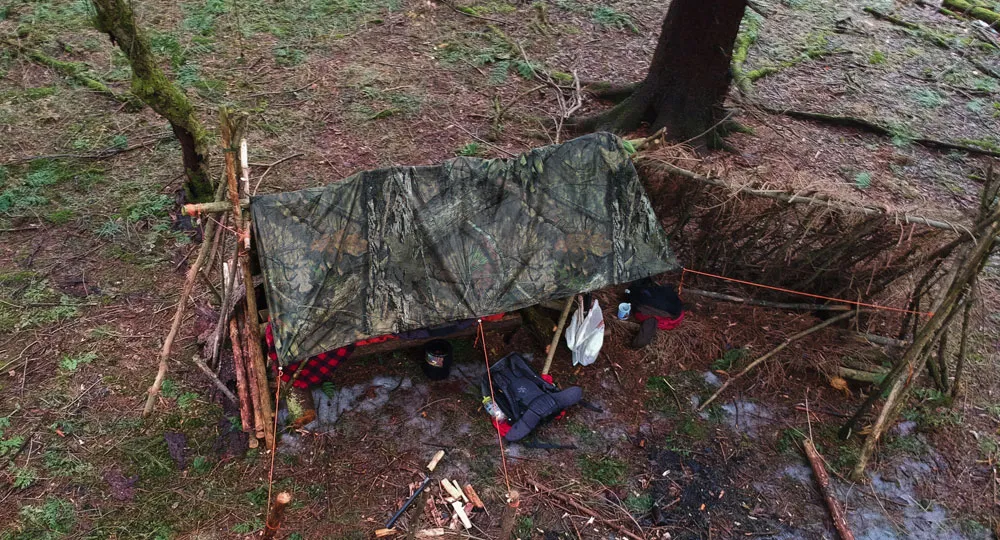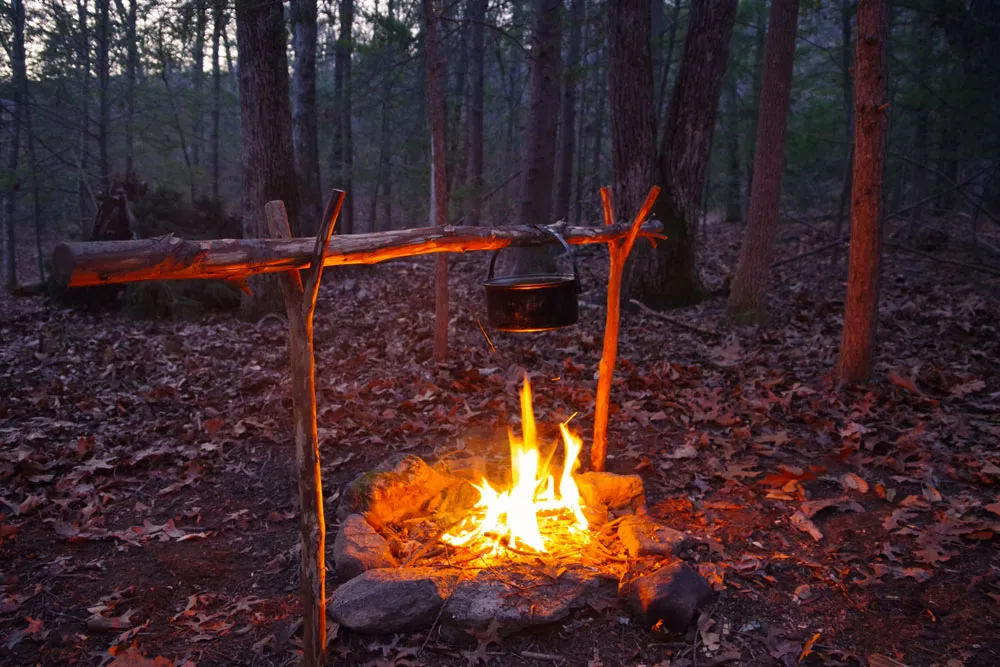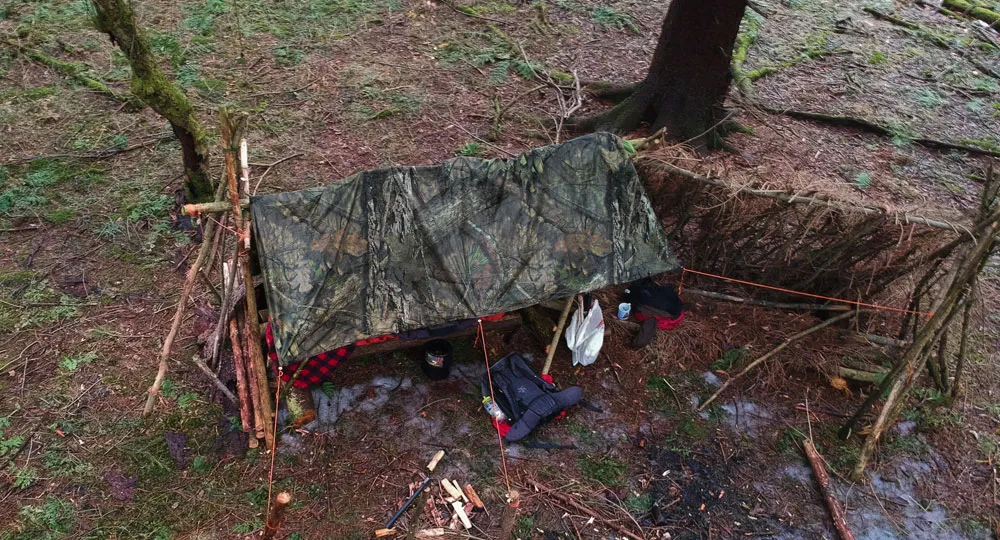
Learning survival skills in your backyard is a safe and easy way to prepare yourself before heading out into the wilderness. Here are eight basic skills to learn and master so you are ready to tackle any survival situation.

1. BUILDING A FIRE
A fire can keep you warm, ward off predators, and provide heat for cooking. Building a fire can be harder than it looks, especially if the weather is damp or overcast or in a survival situation when you have few or no supplies.
There are several innovative ways you can create fire without any gear, but they require practice and patience. Testing a few fire-building skills in your backyard is an excellent way to prepare for an emergency.
Practice finding or creating dry tinder by carving a feather stick or hunting for amadou, a fungus that grows in the bark of coniferous trees. You can also dig around your backyard for quartz to make a flint that can generate a spark.
2. CREATING POTABLE WATER
Sourcing clean drinking water is perhaps the single most important skill needed in a survival situation. Unfortunately, natural water sources are not always hygienic and can harbor parasites, viruses, and bacteria. You can create potable water in the wild with a few simple techniques that you can easily practice at home.
The easiest way to purify water in the wild is to boil it, but you may be left with sediment or other particulate matter that affects the taste. Filter the water through a t-shirt, or build a filtration system using charcoal from your fire, sand, and small river rocks inside an upside-down PET bottle.
If you cannot find a source of water, you can practice drawing water from the earth by building a solar still. A solar still consists of a hole approximately two feet across by one foot deep. Place a container at the bottom and cover the hole with a tarp or plastic sheet, sealing the edges with dirt or sand. Place a small rock in the center of the cover, and moisture will condense on the underside of the cover and rip into the container.

3. FORAGING FOR FOOD
It’s surprising how many edible wild plants are available in your backyard farm or around your neighborhood. In a survival situation, plants are a vital source of nutrients that can provide a low-impact source of energy.
Identifying edible plants can be tricky, as many toxic species have similar characteristics as non-toxic ones. But there are a few easily identifiable plants growing rampantly across the country that are not only nutrient-dense but also delicious, including stinging nettle, dandelion, lamb’s quarters, and miner’s lettuce.
If you are inexperienced at foraging for food, it is best to avoid fungi and mushrooms, as many species are deadly. You can also brush up on your identification techniques in your backyard by consulting a local botanical guidebook.
4. TYING KNOTS
An often-overlooked skill, knot-tying can help your chances of survival by helping you build a shelter, set snares, and create tools. Learning how to tie secure knots takes time and practice, so grab a rope and brush up on your knot-tying skills.
5. MAKING A WEAPON
If you find yourself in the wilderness without a weapon, you have little defense against predators looking for an easy meal. A slingshot is an underrated tool that is quick and easy to make from basic materials you can find at home. All you need is a forked stick, rubber tubing, and leather or canvas for the pad.
Once you have constructed your slingshot, set up a few targets around your yard and practice aiming and shooting. Wear eye protection and ensure that no one enters your line of sight as you release your ammo.

6. BUILDING A SHELTER
Searching for shelter is one of the first tasks to accomplish if you get lost in the wilderness, but a safe place to keep out of the elements can be hard to find. Put your childhood fort-building skills to good use and practice constructing a makeshift shelter in your backyard.
Depending on the terrain, environment, and season, there are several options for shelters that you can build. Start with a basic lean-to or tarp-tent, and gradually build up your skills until you are comfortable lashing together long branches to form a teepee. If you live in an area with heavy winter snows, you can take advantage of the cold weather to practice digging a snow cave shelter.
7. BASIC FIRST AID
When you’re out in the wilderness, it can be difficult for emergency services to reach you if you are sick or injured. Understanding and being able to administer first aid may save your life or the life of someone you love.
Grab a friend, partner, or family member and practice administering first aid for a series of common threats in survival situations. These include the basic CPR procedure, controlling bleeding, treating burns, stabilizing limbs, and finding soothing plants for insect stings and abrasions.
8. FISHING AND TRAPPING
Setting a snare to catch small game and survival fishing are essential skills that allow you to obtain valuable sources of protein with little energy expenditure. Snares and fishing techniques vary, depending on your prey, so it is important to practice setting a variety of different snares and deploying a range of fishing techniques so you are prepared for any situation.
If you practice setting snares in your backyard, make sure you disassemble them after you are done to avoid injuring local wildlife or neighborhood pets.
The Takeaway
Don’t wait until you are stuck in the wilderness to practice your survival skills. Learning essential skills such as fire building and constructing a shelter is a great weekend project you can do in the safety of your backyard.





